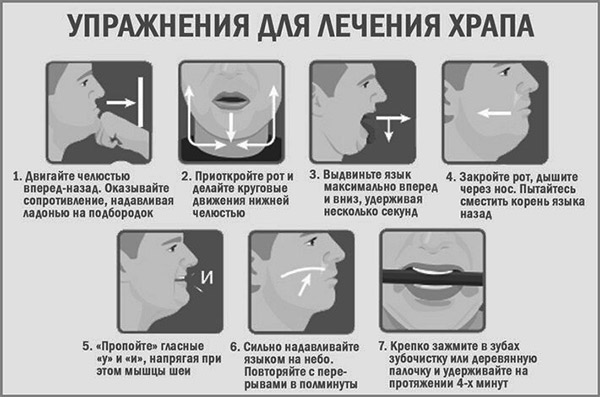Medical expert of the article
New publications
Exercises for snoring, or Myofunctional Therapy
Last reviewed: 29.06.2025

All iLive content is medically reviewed or fact checked to ensure as much factual accuracy as possible.
We have strict sourcing guidelines and only link to reputable media sites, academic research institutions and, whenever possible, medically peer reviewed studies. Note that the numbers in parentheses ([1], [2], etc.) are clickable links to these studies.
If you feel that any of our content is inaccurate, out-of-date, or otherwise questionable, please select it and press Ctrl + Enter.

Studies have shown that snoring exercises for the mouth and throat help tone the muscles of the airway so that snoring is less frequent and noisy. [1]
However, if snoring is caused by a deviated nasal septum, adenoids or nasal polyps, no exercise will not help, and you need medication or surgery.
Indications
Exercises for snoring in women and men do not differ in any way, and experts consider the weakening of the tone of the soft palate muscle, which raises its distal part upwards; the uvula muscle (which raises the uvula); the palatine-lingual and palatine-pharyngeal muscles to be indications for their performance. By the way, oral myofunctional therapy is used in the treatment of bite anomalies, and many of its exercises have long been used in speech therapy.
Snoring and obstructive night apnea result from weakened airway muscles, improper tongue position and breathing through the mouth during sleep. Oropharyngeal exercises - myofunctional therapy - can tone the airway and tongue muscles, promoting nasal breathing.
Contraindications
Contraindications to their performance include already mentioned above adenoids or polyps in the nose, malformations of the nasal septum, hyperplasia of the uvula (uvula), hypertrophy of the palatine tonsils, as well as the presence of chronic diseases of the nasopharynx (including adenoiditis, nasopharyngitis, inflammation of the paranasal sinuses) that impede nasal breathing, the acute stage of allergic or vasomotor rhinitis, and the use of sedatives that relax the muscles of the posterior pharyngeal wall.
Description of the exercise
It should be noted that Strelnikova's exercise for snoring is actually a breathing exercise for asthma and bronchitis choking attacks and for the vocal cords of singers (A. Strelnikova was an opera singer and vocal teacher).
It is also inappropriate to consider the so-called exercises of Eugene Green from snoring, because this blogger has nothing to do with medicine, and his main occupation is various business trainings on the Internet.
But the following technique of exercises to increase the tone of the muscles of the oropharynx, including exercises for the palate from snoring, is based on proven and used in foreign practice methods.
Any training takes time to achieve positive results, and the duration of these exercises is not regulated: everything depends on individual orofascial features.
A big plus is that you can perform these exercises from snoring at home; their sequence and combination can vary at your own discretion, but the desirable frequency of performance - three to four times a day (with a total duration of up to 15-20 minutes).

To strengthen and tone the muscles of the tongue and soft palate, it is recommended to perform the following exercises (each of which should be repeated at least 5-10 times):
- I. Press the tip of the tongue against the back of the front upper teeth and gently push it backwards - along the palate.
- II. Stick out the tongue to try to reach the tip of the nose, hold for a few seconds, and then relax and hide the tongue in the oral cavity.
- III. Try to reach the chin with the tongue out. Then - similarly to the previous exercise.
- IV. Press the tongue against the palate and hold for a few seconds and then relax.
- V. With tongue out, move it as far left and right as possible (alternately).
Exercises that help tone the mandibular, facial and pharyngeal muscles:
- I. Pressing the lips together, close the mouth tightly and then open the mouth, relaxing the jaw and lips.
- II. With the mouth open, squeeze and relax the muscle of the back wall of the throat for 15-20 seconds (the uvula will move up and down).
- III. Opening the mouth, alternately shift the lower jaw to the right and left (holding it for 10 seconds at the point of maximum shift).
To improve nasal breathing can help such a simple exercise: with closed mouth and relaxed lower jaw, inhale through the nose, one nostril is closed (pressing a finger against the nasal septum) and the air is slowly exhaled through the open nostril. The exercise is performed on each nostril in turn.
And to strengthen the muscles of the larynopharynx, it is useful to pronounce vowel sounds, stretching them, as well as singing.
A list of authoritative books and studies related to the study of snoring treatment
- "Multimodal Management of Canine Osteoarthritis" - by Felix Duerr, Randy A. Boudrieau (Year: 2016)
- "Sleep Disorders Medicine: Basic Science, Technical Considerations, and Clinical Aspects" - by Sudhansu Chokroverty, Robert J. Thomas (Year: 2017)
- "Oral Appliance Therapy in Obstructive Sleep Apnea" - by B. Gail Demko (Year: 2015)
- "Manual of Clinical Behavioral Medicine for Dogs and Cats" - by Karen Overall, Jacqueline C. Neilson (Year: 2013)
- "Myofunctional Therapy" - by Wanda Sturm (Year: 2016)
- "Oral Motor Assessment and Treatment: Ages and Stages" - by Diane Bahr (Year: 2018)
- "Treatment of Sleep Apnea and Snoring: An Oral Appliance Approach" - by Peter A. Cistulli, Atul Malhotra (Year: 2017)
- "Orofacial Myology: International Perspectives" - by Sandra R. Holtzman (Year: 2013)
- "Sleep Apnea: Pathogenesis, Diagnosis and Treatment" - by Clete A. Kushida (Year: 2011)
- "Breathing Disorders in Sleep" - by Atul Malhotra (Year: 2014)
Literature
- Roman Buzunov, Elena Tsareva, Irina Leheida, Snoring and obstructive sleep apnea syndrome in adults and children. A practical guide for physicians, LitRes, 2020.
- Yulia Popova, How to stop snoring and let others sleep,Krylov IR, 2018.
- Roman Buzunov, Sofia Cherkasova. How to treat snoring and obstructive sleep apnea syndrome, 2020.

